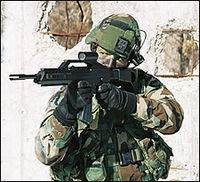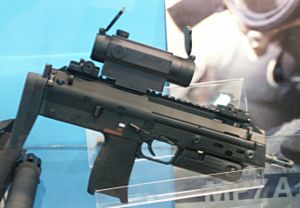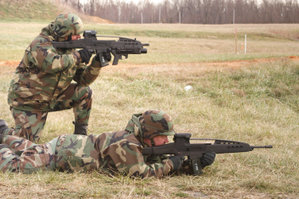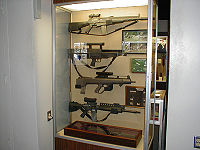
Objective Individual Combat Weapon program
Encyclopedia

The Objective Individual Combat Weapon or OICW was the next-generation service rifle
Rifle
A rifle is a firearm designed to be fired from the shoulder, with a barrel that has a helical groove or pattern of grooves cut into the barrel walls. The raised areas of the rifling are called "lands," which make contact with the projectile , imparting spin around an axis corresponding to the...
competition that was under development as part of the United States Army
United States Army
The United States Army is the main branch of the United States Armed Forces responsible for land-based military operations. It is the largest and oldest established branch of the U.S. military, and is one of seven U.S. uniformed services...
OICW program; the program was eventually discontinued without bringing the weapon out of the prototype phase. The acronym OICW is often used to refer to the entire weapons program.
It was started in the aftermath of the Advanced Combat Rifle
Advanced Combat Rifle
The Advanced Combat Rifle was a United States Army program to find a replacement for the M16 assault rifle. The program's total cost is approximately US$300 million...
(or ACR) during the 1980s. Like the ACR program, it has largely been a failure in terms of achieving the specific program goals (e.g. replacing the M16
M16 rifle
The M16 is the United States military designation for the AR-15 rifle adapted for both semi-automatic and full-automatic fire. Colt purchased the rights to the AR-15 from ArmaLite, and currently uses that designation only for semi-automatic versions of the rifle. The M16 fires the 5.56×45mm NATO...
) and has cost millions of dollars, but has resulted in many innovative weapons and weapon concepts as well as offshoot programs of its own.
Development

Overview
The central idea of the program was to develop a rifle that enabled the attacking of targets behind cover by using airburst munitions. The munitions were to be much smaller than pre-existing grenades and grenade launchers, but large enough to be effective. The idea was refined into a combination of a short assault rifleAssault rifle
An assault rifle is a selective fire rifle that uses an intermediate cartridge and a detachable magazine. Assault rifles are the standard infantry weapons in most modern armies...
and semi-automatic, low-velocity cannon
Cannon
A cannon is any piece of artillery that uses gunpowder or other usually explosive-based propellents to launch a projectile. Cannon vary in caliber, range, mobility, rate of fire, angle of fire, and firepower; different forms of cannon combine and balance these attributes in varying degrees,...
firing air-bursting munitions. The OICW aimed to use advances in computer technology in a weapon that fired grenades automatically pre-set to explode above or beside targets hidden from view. Fragmentation from the exploding grenades would defeat the target when normal rifle fire would be ineffective.
First competition
The winners of the first competition for the project during the 1990s were ATK and firearms manufacturer Heckler & KochHeckler & Koch
Heckler & Koch GmbH is a German defense manufacturing company that produces various small arms. Some of their products include the SA80, MP5 submachine gun, G3 automatic rifle, the G36 assault rifle, the HK 416, the MP7 personal defense weapon, the USP series of handguns, and the high-precision...
with the XM29 OICW
XM29 OICW
The XM29 OICW was a series of prototypes of a new type of battle rifle that fired 20 mm HE airbursting projectiles. The prototypes were developed as part of the Objective Individual Combat Weapon program in the 1990s...
. They went on to build numerous prototypes of the rifle for the United States
United States
The United States of America is a federal constitutional republic comprising fifty states and a federal district...
military in the late 1990s. These projects centered on using a programmable 20 mm airburst munition-firing rifle by itself or with other projectile-based weapons attached. The 20 mm launcher was analyzed in various configurations, including a launcher by itself, with a 5.56 mm weapon (based on the HK G36
Heckler & Koch G36
The Heckler & Koch G36 is a 5.56×45mm assault rifle, designed in the early 1990s by Heckler & Koch in Germany as a replacement for the 7.62mm G3 battle rifle. It was accepted into service with the Bundeswehr in 1997, replacing the G3...
), or with a MP7
Heckler & Koch MP7
The MP7 is a German submachine gun manufactured by Heckler & Koch and chambered for the 4.6×30mm cartridge. It was designed with the new cartridge to meet NATO requirements published in 1989, as these requirements call for a personal defense weapon class firearm, with a greater ability to defeat...
PDW.
XM29
By the early 2000s, the weapon had settled on a design and was classified as the XM29. The XM29 was based on a the HK CAW (Close Assault Weapon) (Cal. 18.5 x 76 or 12 Gauge non-conventional). However, the weapon had serious problems - it did not meet weight or cost targets, and the 20 mm XM1019 High Explosive Air Bursting (HEAB) did not seem to be lethal enough in testing. To compound matters, the kinetic-energy component had to be light and short in length. As a result the 5.56x45mm NATO5.56x45mm NATO
5.56×45mm NATO is a rifle cartridge developed in the United States and originally chambered in the M16 rifle. Under STANAG 4172, it is a standard cartridge for NATO forces as well as many non-NATO countries. It is derived from, but not identical to, the .223 Remington cartridge...
barrel had a length of only 250mm (9.8 inches), which is too short to generate enough muzzle velocity to be effective. It was also too heavy and too large to be operated effectively by a soldier.
XM8 and XM25
This resulted in the army starting development on new weapons, and finally shelving the XM29 in 2004. The kinetic energy component split off into the XM8 rifleXM8 rifle
The XM8 was a developmental U.S. Military designation and project name for a lightweight assault rifle system that was under development by the United States Army from the late 1990s to early 2000s...
program and the airburst component developed into the XM25
XM25
The XM25 Counter Defilade Target Engagement System, also known as the Punisher, Individual Semiautomatic Air Burst System, and the Bowling Tube is an air burst grenade launcher derived from the XM29 OICW...
airburst weapon. According to a presentation by Major
Major
Major is a rank of commissioned officer, with corresponding ranks existing in almost every military in the world.When used unhyphenated, in conjunction with no other indicator of rank, the term refers to the rank just senior to that of an Army captain and just below the rank of lieutenant colonel. ...
Kevin Finch, Chief of the Small Arms Division of the Directorate of Combat Developments at the U.S. Army Infantry Center, there were three main parts to the OICW program.
Increment 1
Increment 1 (OICW 1) was a competition for a whole weapon system family similar to the XM8XM8 rifle
The XM8 was a developmental U.S. Military designation and project name for a lightweight assault rifle system that was under development by the United States Army from the late 1990s to early 2000s...
. The weapon system was to potentially replace the M4 carbine
M4 carbine
The M4 carbine is a family of firearms tracing its lineage back to earlier carbine versions of the M16, all based on the original AR-15 designed by Eugene Stoner and made by ArmaLite. It is a shorter and lighter variant of the M16A2 assault rifle, with 80% parts commonality.It is a gas-operated,...
, M16 rifle
M16 rifle
The M16 is the United States military designation for the AR-15 rifle adapted for both semi-automatic and full-automatic fire. Colt purchased the rights to the AR-15 from ArmaLite, and currently uses that designation only for semi-automatic versions of the rifle. The M16 fires the 5.56×45mm NATO...
, M249 light machine gun
Light machine gun
A light machine gun is a machine gun designed to be employed by an individual soldier, with or without an assistant, as an infantry support weapon. Light machine guns are often used as squad automatic weapons.-Characteristics:...
and some M9 pistol
M9 Pistol
The Beretta M9, formally Pistol, Semiautomatic, 9mm, M9, is a 9×19mm Parabellum pistol of the United States military adopted in 1985. It is essentially a military specification Beretta 92F, later the 92FS....
s. Other arms companies had contended that the OICW project goals had changed enough to warrant another competition. Potential challengers could include a weapons system based on an updated M16, the Steyr AUG
Steyr AUG
The AUG is an Austrian bullpup 5.56mm assault rifle, designed in the early 1970s by Steyr Mannlicher GmbH & Co KG . The AUG was adopted by the Austrian Army as the StG 77 in 1977, where it replaced the 7.62mm StG 58 automatic rifle...
, the aforementioned FN SCAR
FN SCAR
The Special Operations Forces Combat Assault Rifle, or SCAR, is a modular rifle made by FN Herstal for the United States Special Operations Command to satisfy the requirements of the SCAR competition. This family of rifles consist of two main types...
, and potentially any other manufacturer that fulfilled the Army requirements for participating. It also listed the shotgun being replaced by a modular shotgun system (XM26 LSS) mounted on the OICW 1 winner.
The Increment 1 portion was put on an eight-week hold in July 2005, primarily to take into account input and needs of other services. On October 31, 2005, the OICW I program was cancelled. The reason given for the cancellation was stated as: "This action has been taken in order for the Army to reevaluate its priorities for small caliber weapons, and to incorporate emerging requirements identified during Operation Enduring Freedom and Operation Iraqi Freedom. The Government will also incorporate studies looking into current capability gaps during said reevaluation."
Increment 2
OICW Increment 2 was a stand-alone airburst weapon the (XM25XM25
The XM25 Counter Defilade Target Engagement System, also known as the Punisher, Individual Semiautomatic Air Burst System, and the Bowling Tube is an air burst grenade launcher derived from the XM29 OICW...
). This is a standalone launcher that uses bigger 25 mm munition, and was intended to be a special applications and support weapon, not an individual combat weapon as previous models were. In 2005, the weapon underwent limited field trials and combat testing.
Increment 3
OICW Increment 3 was the XM29. The M203 was listed as being replaced by a combination of Increments 2 and 3. The M249 was also to be partially replaced by a lightweight MG (LMGA, now LSAT), which was listed as being the successor to the M60M60 machine gun
The M60 is a family of American general-purpose machine guns firing 7.62×51mm NATO cartridges from a disintegrating belt of M13 links...
and M240.
OICW-related weapons

- Original OICW Concept, OICW program targets drafted (circa 1980s/early 1990s)
- OICW concepts/prototypes in 1990s
- 20 mm smart grenade and 5.56 mm rifle in side by side configuration
- 20 mm smart grenade stand alone unit
- 20 mm smart grenade and MP7
- 20 mm smart grenade and 5.56 mm rifle in over-under configuration (XM29 OICWXM29 OICWThe XM29 OICW was a series of prototypes of a new type of battle rifle that fired 20 mm HE airbursting projectiles. The prototypes were developed as part of the Objective Individual Combat Weapon program in the 1990s...
)
- Program temporarily suspended circa 2004. Restarted with separate 'increments' for different weapons.
- Some weapon programs involved with, stemming from, or using technology from the OICW project
- XM1018 (HEAB Ammunition)
- XM8 rifleXM8 rifleThe XM8 was a developmental U.S. Military designation and project name for a lightweight assault rifle system that was under development by the United States Army from the late 1990s to early 2000s...
(5.56 kinetic energy component) - XM25XM25The XM25 Counter Defilade Target Engagement System, also known as the Punisher, Individual Semiautomatic Air Burst System, and the Bowling Tube is an air burst grenade launcher derived from the XM29 OICW...
(Uses low velocity 25 mm smart airburst munition) - XM109 (Uses 'high velocity' 25 mm 'dumb' version of smart munition)
- XM307 ACSW (Uses 'high velocity' 25 mm smart airburst munition; autocannon)
- XM312XM312The XM312 is a heavy machine gun derived from the XM307 25 mm autocannon and chambered for the .50 BMG cartridge. It was designed in response to a request by the U.S...
(.50 BMG version of XM307)
- XM312
- Mk 47 (Mk 47 Mod 0) (40 mm automatic grenade launcher capable of using smart 40 mm airburst grenades)
- Land WarriorLand WarriorLand Warrior is a United States Army program, cancelled in 2007, that was to use a combination of commercial, off-the-shelf technology and current-issue military gear and equipment designed to:* integrate small arms with high-tech equipment;...
- XM26 Lightweight Shotgun System (A lightweight shotgun attachment)
- M320 (40 mm grenade launcher)

See also
Weapons:- XM8 rifleXM8 rifleThe XM8 was a developmental U.S. Military designation and project name for a lightweight assault rifle system that was under development by the United States Army from the late 1990s to early 2000s...
- XM25XM25The XM25 Counter Defilade Target Engagement System, also known as the Punisher, Individual Semiautomatic Air Burst System, and the Bowling Tube is an air burst grenade launcher derived from the XM29 OICW...
- XM29 SABR
- 80.00280.002The 80.002 is a combined Assault Rifle/Grenade Launcher based on the AK platform that pre-dated the similar OICW. In developing this set of designers participated V. Minaev, VI Chelikin, GA Jan. The main difference from the Kalashnikov is the presence of weapons of two adjacent shafts 5.45 mm and...
- AICWAdvanced Individual Combat WeaponThe Advanced Infantry Combat Weapon was a prototype assault rifle based on the F88 Austeyr being developed in Australia. The AICW combines a standard 5.56 mm assault rifle with a multiple-shot grenade launcher....
- FN F2000FN F2000The FN F2000 is a 5.56×45mm NATO bullpup assault rifle, designed by FN Herstal in Belgium. The F2000 made its debut in March 2001 at the IDEX defense exhibition held in Abu Dhabi, in the United Arab Emirates.-Design details:...
- PAPOPPAPOPThe PAPOP is a French project to construct a computerised multi-usage infantry weapon for the FÉLIN system, capable of hitting hidden or protected targets...
- Daewoo K11
- Neopup PAW-20Neopup PAW-20The Neopup PAW-20 is a grenade launcher designed by Tony Neophytou and is marketed by Denel. -Overview:...
Programs/Projects:
- Special Purpose Individual WeaponSpecial Purpose Individual WeaponThe Special Purpose Individual Weapon was a long-running United States Army program to develop, in part, a workable flechette-based "rifle", though other concepts were also involved...
(SPIW) (Project SALVO, etc.) - Advanced Combat RifleAdvanced Combat RifleThe Advanced Combat Rifle was a United States Army program to find a replacement for the M16 assault rifle. The program's total cost is approximately US$300 million...
- Close-Assault Weapon SystemHK CAWSThe Heckler & Koch HK CAWS is a prototype automatic shotgun—designed as a combat shotgun—co-produced by Heckler & Koch and Winchester/Olin during the 1980s...
- Australia's Advanced Individual Combat WeaponAdvanced Individual Combat WeaponThe Advanced Infantry Combat Weapon was a prototype assault rifle based on the F88 Austeyr being developed in Australia. The AICW combines a standard 5.56 mm assault rifle with a multiple-shot grenade launcher....
program
Lists:
- List of individual weapons of the U.S. Armed Forces
- List of crew served weapons of the US Armed Forces
- List of modern infantry related terms and acronyms

External links
- More information including pictures
- Global Security entry
- Jane's Defense news on OICW program in May 2005
- Janes Defense news on OICW program in August 2000
- Pre-solicitation notice for OICW increment 1
- DefenseReview entry on sources sought for Non-Developmental multi-configurable 5.56 mm modular weapon system
- Military Factory Small Arms
- OICW I canceled

